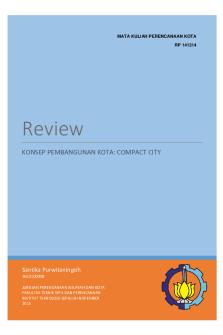Triumph of the City A Critical Review PDF

| Title | Triumph of the City A Critical Review |
|---|---|
| Course | Interior Architecture |
| Institution | Liberty University |
| Pages | 6 |
| File Size | 89.5 KB |
| File Type | |
| Total Downloads | 107 |
| Total Views | 146 |
Summary
The objective of this assignment is to enhance reading and note-taking skills and introduce
students to critical debates in City Studies. ...
Description
Triumph of the City: A Critical Review Name Institutional Affiliations Date
Introduction Edward Glaeser is hailed as one of the greatest economic thinkers when he was at the age of forty. His work is an outstanding compilation of decades of investigation on the role of cities towards the success of the people. He takes a tour around the world trying to understand urban economics. Through interactions with different cities, leaders, politicians, and other economists, Glaeser finds the appropriate words to explain how cities have come to thrive from their point of birth to their current status. Further, Glaeser provides a tough perception of the poorly reasoned public policies while at the same time chastises city planners in Mumbai and Paris for opting for building up and up. The Triumph of the City is an ultimate repletion of heartwarming visions. Unexpectedly, even cities such as Mumbai renowned for great slums have some reasonably high marks. In overall, Glaeser’s Triumph of the City is an excellent roadmap to a successful, prosperous, and just city, however, some of the author’s arguments are found to be disputable. Summary Edward Glaeser’s Triumph of the City (2011) is a well-thought-out book that offers a reader with an in-depth recipe book for a successful city as well as the ingredients that precede the downfall of a city. Glaeser performs a critical examination of how cities came to be, and how, despite the complete changes in technology, culture, and medicine among others, cities continue to flourish and to become an integral driving force to the world’s development. In Triumph of the City, Glaeser further discusses how cities can thrive better in the future. Additionally, he offers the viewpoint on how cities should lead by example by turning both urban metropolitans and rural outcrops into environmentally friendly places. Through the use of real-world examples, Glaeser emphasizes three main topics: what creates good and bad cities, why urbanism thrives over ruralism, and how humans can build upon cities. The Triumph of the City is a promising
book that indicates that tries to indicate that the power of growth and success of a city resides within the people that live in those cities and the level of ideas circulation set by these people. When combined with the continued rise in literacy levels, creativity and innovation spur the observable growth that is observable within the diverse urban. Critical Review Glaesar’s book The Triumph of the City primarily asserts that the core function of cities is and has always been proximity. For example, Glaeser indicates that New York City initially began as a shipping hub due to its proximity and convenient location. In turn, it promoted the flourishing of manufacturing companies near the harbor since they could easily access incoming cargo. That saw the birth of a city. Glaeser provides different ways through which cities sprouted. However, the general purpose was the convenience they gave all parties involved: proximity. Ultimately, the key issue in this context is not simply proximity, cities provide the platform through which people meet and nurture great ideas together. Glaeser stresses the value of a faceto-face meeting. While different technologies such as video chatting and telephone were meant to bring people closer even without the need to be together, Glaeser indicates that they were meant to be a compliment and not a replacement (p. 34). Pollution and diseases have predominantly been identified with cities. Glaeser, however, indicates that the public government has the responsibility and ability to remedy this problem. He identifies two main combatants that help in eliminating the same in all cities as proper sanitation and clean drinking water (p. 193). Currently, nearly all cities in developed countries and many in developing countries have managed to provide these essentials, while the rural villages and the poor remain unlucky. The primary obligation of the government is to its people. Proper sanitation and clean drinking water are some of the core basic needs of all. When these
needs are not met, citizens often leave looking for places where they are easily accessible. In regard to pollution, Glaeser provides some amazing statistics that indicate how cities are indeed greener just as any other place. For example, Gaeler indicates that people living in cities require about 687 gallons of gas annually while those living in rural areas require 1164 gallons of gas annually (p. 207). Simply put, the denser the city, the lesser the energy required for transportation. On the other hand, people living in the suburbs require more fuel to cover the greater distances by car. The author tries to explain the origin of cities. However, he does not present conclusive evidence to indicate whether they are truly better than exurbs. For example, the question of crime and corruption are evidently rampant in some places than others and their consequences are debilitating. Glaeser, in reference to economist Gary Becker, indicates that a 5 percent increase in policemen resulted in a 5 percent reduction in crime. If you view this from the surface, the statistics might not be sensible enough to indicate an efficient use of manpower. However, if you consider the conviction rate and the level punishment, it becomes easier to understand how the crime rate is lowered (p. 111). Glaeser’s work, however, presents one point of contention. His claim that cities don’t create poverty, rather, they are an attraction to the poor people (p. 70). Looking at this, the ultimate suggestion is that cities presents many opportunities for growth for the poor, a place where they can be able to rise out of their poverty while at the same time making a living. Undoubtedly, this assertion has some truth to some extent especially if we consider developing countries which are currently experiencing high urbanization rates. However, for developed countries, the cycle of poverty is well-understood with many people living in poverty for generations. The implication is that, most poor people in cities are not utterly new arrivals. That
is, this aspect has been established and is a mundane aspect of the city life. However, Glaeser does make a salient point which can be translated that the poor always find cities better than living in the rural areas. Conclusion Conclusively, most of what the Glaeser in the Triumph of the City presents is irrefutably agreeable. The fact that he views cities as the surest pathway to a good life. The intriguingly large information he provides about different cities across the globe presents an underlying conceptual schema that explains why people chose to live in cities. Undeniably, Triumph of the City is an ideal reading for any government and any layperson who wants to understand how cities develop. While the book does not simply impress to any government since it places a high burden on the government and constantly reminds them of their responsibilities, it’s important since it focuses on how best a city can grow. The extensive reading indicates that government should start focusing on people rather than worrying about places. Apparently, cities that have managed to be successful in the past are an emblem that developing cities can emulate. However, for these cities to retain their glory and for the developing cities to be successful, it’s important that they scale down their ambitions. Instead, they should focus on improving the success of their people since cities are simply people.
References Glaeser, E. (2011). Triumph of the City : How our Greatest Invention makes us Richer, Smarter, Greener, Healthier, and Happier. New York: The Penguin Press....
Similar Free PDFs

17-writing-a-critical-review
- 2 Pages

Critical Review
- 6 Pages

Critical review
- 4 Pages

Review Compact City
- 13 Pages

THE IMAGE OF THE CITY Kevin Lynch
- 103 Pages

Critical analysis of the iliad
- 3 Pages
Popular Institutions
- Tinajero National High School - Annex
- Politeknik Caltex Riau
- Yokohama City University
- SGT University
- University of Al-Qadisiyah
- Divine Word College of Vigan
- Techniek College Rotterdam
- Universidade de Santiago
- Universiti Teknologi MARA Cawangan Johor Kampus Pasir Gudang
- Poltekkes Kemenkes Yogyakarta
- Baguio City National High School
- Colegio san marcos
- preparatoria uno
- Centro de Bachillerato Tecnológico Industrial y de Servicios No. 107
- Dalian Maritime University
- Quang Trung Secondary School
- Colegio Tecnológico en Informática
- Corporación Regional de Educación Superior
- Grupo CEDVA
- Dar Al Uloom University
- Centro de Estudios Preuniversitarios de la Universidad Nacional de Ingeniería
- 上智大学
- Aakash International School, Nuna Majara
- San Felipe Neri Catholic School
- Kang Chiao International School - New Taipei City
- Misamis Occidental National High School
- Institución Educativa Escuela Normal Juan Ladrilleros
- Kolehiyo ng Pantukan
- Batanes State College
- Instituto Continental
- Sekolah Menengah Kejuruan Kesehatan Kaltara (Tarakan)
- Colegio de La Inmaculada Concepcion - Cebu









